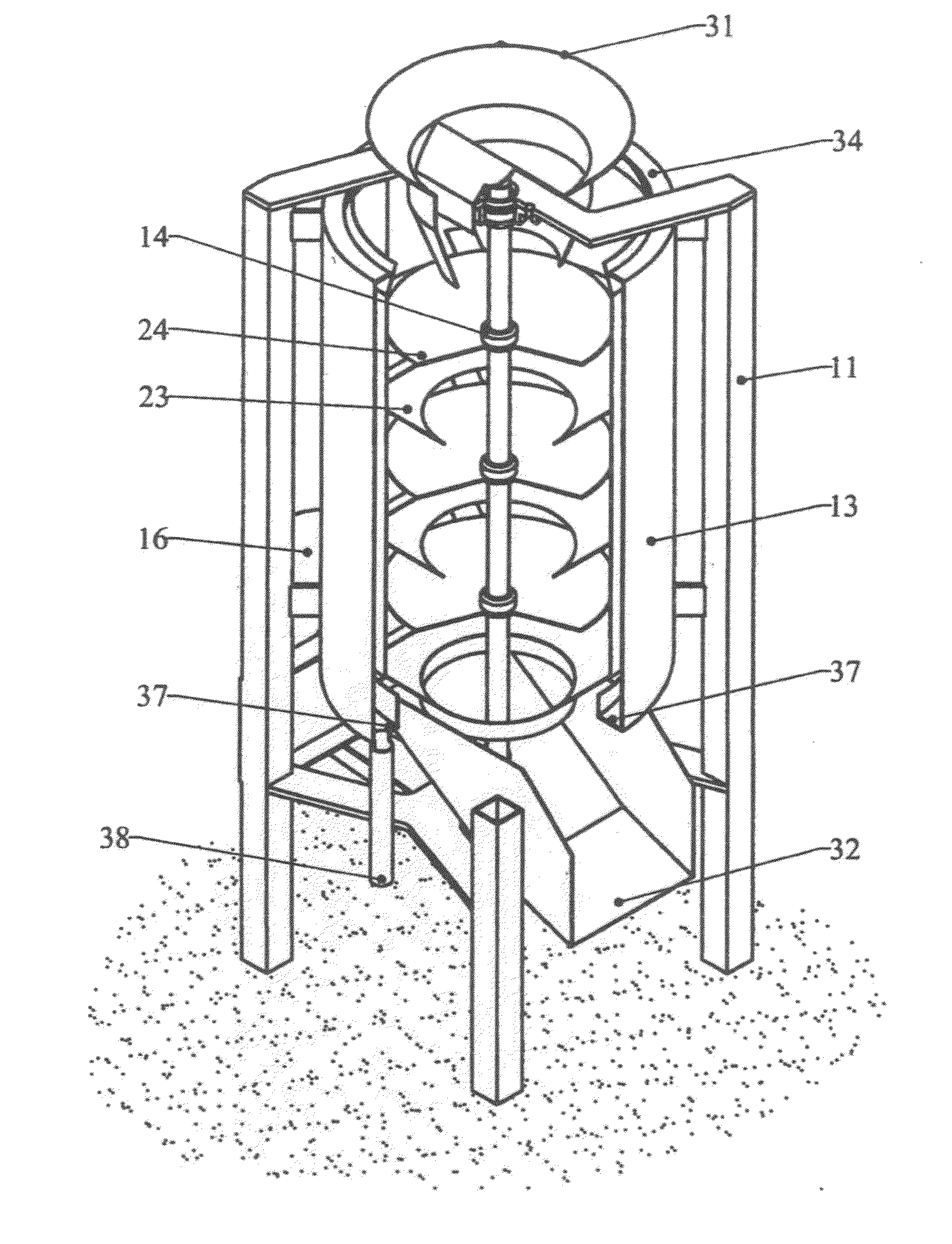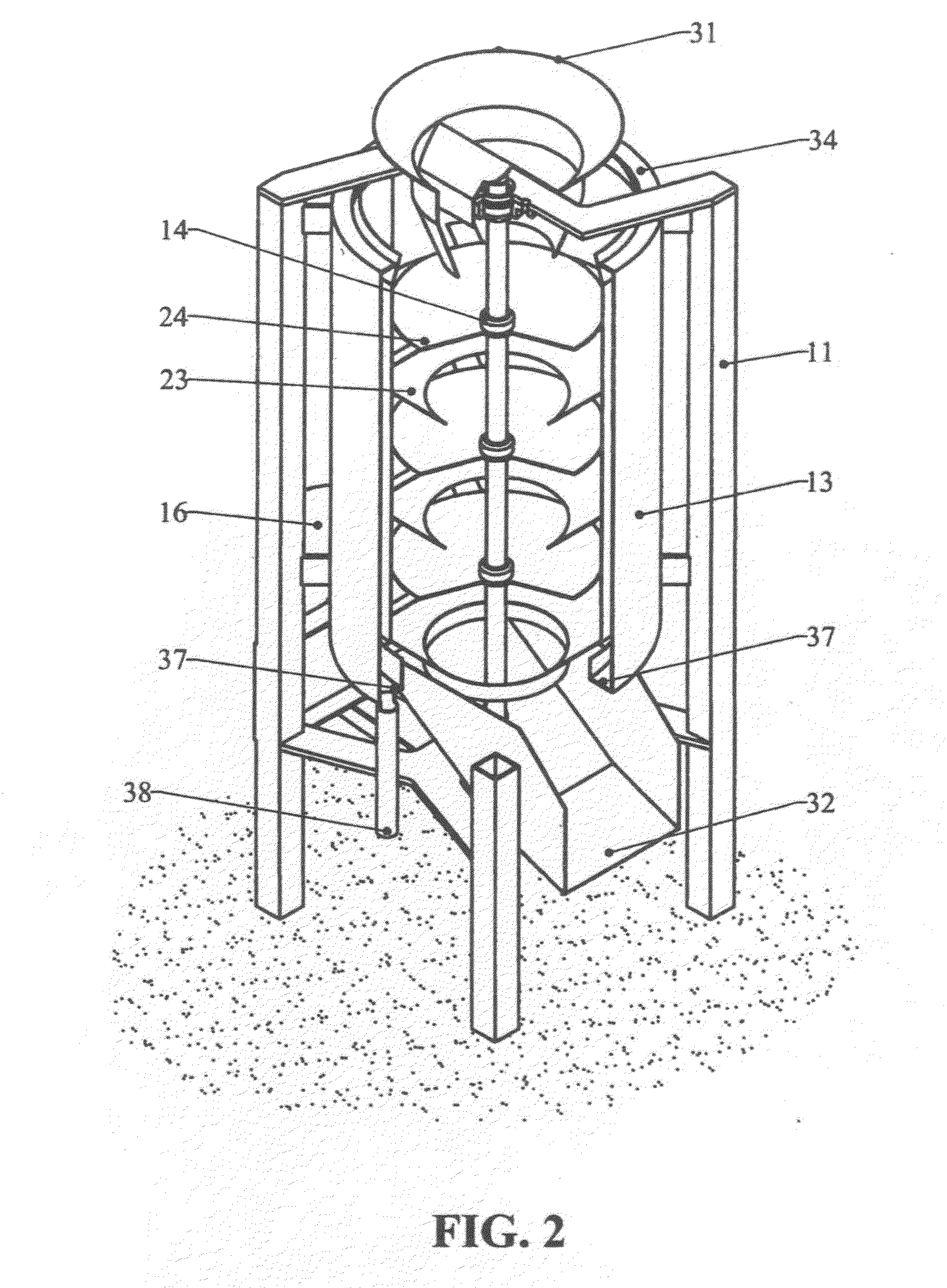Method and apparatus for separating cooking oils from snack food products through a quasi-continuous centrifuge action
a centrifuge action and cooking oil technology, applied in the direction of separation process, lighting and heating apparatus, centrifuges, etc., can solve the problems of undesirable cooking oil “carrying out”, batch process rendering non-continuous an otherwise continuous process, batch process, etc., to achieve minimal product damage, low rotational speed, and minimal affecting the shape and texture of the product
- Summary
- Abstract
- Description
- Claims
- Application Information
AI Technical Summary
Benefits of technology
Problems solved by technology
Method used
Image
Examples
example 1
[0026]Expanded pellets of approximately rectangular shape 50 mm by 40 mm by 4 mm thick and having irregular, wavy surface texture and shape were fed continuously at a rate of 60 kg / hr, directly from the fryer into a centrifuge having a 3-stage, 400 mm diameter drum. The centrifuge was running at 9.2 seconds cycle duration, as follows:
[0027]1) 0.2 seconds acceleration time;
[0028]2) 5 seconds at high speed of 550 rpm;
[0029]3) 1 second deceleration time;
[0030]4) 3 seconds at low speed of 30 rpm.
[0031]Samples of pellets taken before and after the centrifuge treatment were compared. Directly from the fryer, the pellets appeared wet, with a liberal coating of oil on the surface of each pellet, and the total oil content of the sample was measured at 14.4%. After centrifuging the pellets appeared noticeably dryer than before and the total oil content of the sample was measured at 9.6%.
example 2
[0032]Expanded pellets in the shape of small donuts of approximately 22 mm outside diameter and 7 mm cross-sectional diameter were fed continuously at a rate of 220 kg / hr, directly from the fryer into a centrifuge having a 2-stage, 400 mm diameter drum. The centrifuge was running at 6.2 seconds cycle duration, as follows:
[0033]5) 0.2 seconds acceleration time;
[0034]6) 4 seconds at high speed of 550 rpm;
[0035]7) 1 second deceleration time;
[0036]8) 1 second at low speed of 30 rpm.
[0037]Samples of pellets taken before and after the centrifuge treatment were compared. Directly from the fryer, the pellets appeared wet, with a substantial quantity of oil retained in the spaces between pellets, and the total oil content of the sample was measured at 27.1%. After centrifuging the pellets appeared noticeably dryer than before and the total oil content of the sample was measured at 13.7%.
example 3
[0038]Expanded pellets in the shape of sticks approximately 150 mm long and oval, approximately 6 mm by 8 mm, in cross section were fed continuously at a rate of 150 kg / hr, directly from the fryer into a centrifuge having a 2-stage, 400 mm diameter drum. The centrifuge was running at 6.2 seconds cycle duration, as follows:
[0039]9) 0.2 seconds acceleration time;
[0040]10) 4 seconds at high speed of 550 rpm;
[0041]11) 1 second deceleration time;
[0042]12) 1 second at low speed of 30 rpm.
[0043]Samples of pellets taken before and after the centrifuge treatment were compared. Directly from the fryer, the pellets appeared wet, with a substantial quantity of oil retained on the surfaces of the sticks, and the total oil content of the sample was measured at 20.5%. After centrifuging the pellets appeared noticeably dryer than before and the total oil content of the sample was measured at 13.1%. In all 3 examples, the degree of de-oiling was similar to that typically achieved in a conventional, ...
PUM
 Login to View More
Login to View More Abstract
Description
Claims
Application Information
 Login to View More
Login to View More - R&D
- Intellectual Property
- Life Sciences
- Materials
- Tech Scout
- Unparalleled Data Quality
- Higher Quality Content
- 60% Fewer Hallucinations
Browse by: Latest US Patents, China's latest patents, Technical Efficacy Thesaurus, Application Domain, Technology Topic, Popular Technical Reports.
© 2025 PatSnap. All rights reserved.Legal|Privacy policy|Modern Slavery Act Transparency Statement|Sitemap|About US| Contact US: help@patsnap.com



